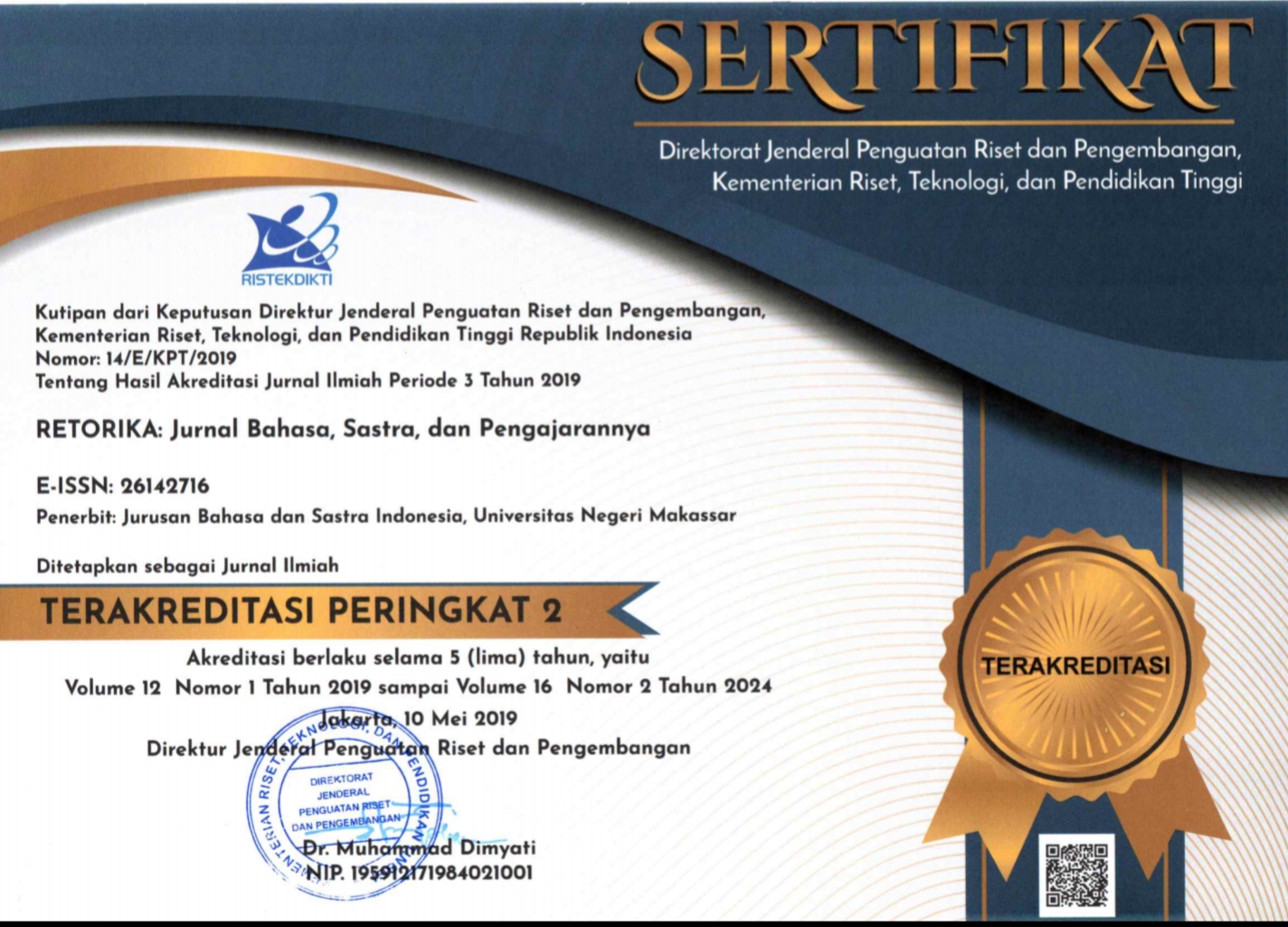UNSUR PEMBENTUK FRASA EKSOSENTRIS DALAM HIKAYAT HANG TUAH
(1) S-2 Linguistik Deskriptif Pascasarjana Universitas Sebelas Maret Surakarta
(2) Guru Besar Fakultas Ilmu Budaya Universitas Sebelas Maret
(*) Corresponding Author
DOI: https://doi.org/10.26858/retorika.v12i2.9468
Abstract
Exocentric Phrase Forming Elements in Hikayat Hang Tuah. The purpose of this study was to describe the exocentric phrase forming elements in Hikayat Hang Tuah. This type of research is descriptive qualitative with the object of research in the form of phrases in Hikayat Hang Tuah. The data in this study are sentences containing exocentric phrases from data sources in the form of Hikayat Hang Tuah book documents. Observation techniques are used in data collection techniques, while the data analysis method in this study is the agih method with techniques for direct elements as a basic technique and advanced techniques in the form of sloping techniques. In Hikayat Hang Tuah there are three types of exocentric phrases (1) exocentric phrases directive with phrase-forming elements in the form of prepositions+nouns; (2) nondirective exocentric phrases with phrase-forming elements, namely particles/designations +adjectives and particles/word designations+nouns; and (3) connective exocentric phrases which form the phrase in the form of conjunctions+verbs. The diversity of linguistic elements in Hikayat Hang Tuah shows the manifestation of literary works as a manifestation of the richness of language.
Keywords
Full Text:
PDFReferences
Afrita, E. 2012. Hikayat Tabut (Suatu Tinjauan Filologi dan Sintaksis). Humanus. 11 (2):189–200.
Ardianto, B. 2017. Penggunaan Struktur Frasa Ek-sosentris Direktif dan Fungsinya dalam Novel “Negeri 5 Menara” (A. Fuadi) dan Impli-kasinya dalam Pembelajaran Bahasa Indonesia di SMA. Aksis (Jurnal Pendidikan Bahasa dan Sastra Indonesia). Vol 1(1): 27–43.
Aridawati, I. A. P. 2012. Perluasan Frasa Tunggal Tipe Eksosentrik Bahasa Bali. Sawerigading, 18 (1):69–78.
Chaer, A. 2012. Linguistik Umum (Edisi Revisi). Jakarta: Rineka Cipta.
Dom, F. M., Sudirman, N., Ibrahim, N. A. 2016. Peranan Adjung dalam Bahasa Melayu: Suatu Analisis Tatabahasa Peranan dan Rujukan. Jurnal Melayu, 15 (1): 67–81.
Hafrianto, J. & Mulyadi. 2018. Kalimat Tanya dalam Bahasa Melayu Dialek Tamiang. Litera, 17(2):186–201.
Jamilah, N. & Maslida. 2018. Representasi Argumen Struktur Konseptual bagi Kata Kerja Kausatif Bahasa Melayu dan Hubungannya dengan Sintaksis. Gema Online (Journal of Langua-ge Studies, 18 (4):143–167.
Keraf, G. 1984. Tata Bahasa Indonesia. Ende Flores: Nusa Indah.
Kridalaksana, H. 2008. Kamus Linguistik. Jakarta: Gramedia Pustaka Utama.
Ramlan. M. 2005. Sintaksis. Yogyakarta: CV. Karyono.
Schap, B. G. 2010. Hikayat Hang Tuah I. Jakarta: Pusat Bahasa.
Sihombing, L. P. & Kentjono, D. 2005. Sintaksis (Dalam Pesona Bahasa). Jakarta: Gramedia Pustaka Utama.
Surono. 2014. Analisis Frasa-Kalimat Bahasa Indo-nesia. Semarang: Gigih Pustaka Pribadi.
Tarigan, H. G. 1986. Pengajaran Sintaksis. Bandung: Angkasa.
Verhaar, J. W. M. 2008. Asas-Asas Linguistik Umum. Yogyakarta: Gadjah Mada University Press.
Article Metrics
Abstract view : 1420 times | PDF view : 215 timesRefbacks
- There are currently no refbacks.
Copyright (c) 2019 Kartika Bintari, Sumarlam Sumarlam

This work is licensed under a Creative Commons Attribution-NonCommercial 4.0 International License.
Published by:
Department of Indonesian Language, Faculty of Languages and Literature, Universitas Negeri Makassar in cooperate with Asosiasi Dosen Bahasa dan Sastra Indonesia (ADOBSI) and Ikatan Program Studi Pendidikan Bahasa dan Sastra Indonesia (IKAPROBSI).
Address: Department of Indonesian Language Office, DG Building Second Floor, UNM Parangtambung, Daeng Tata Raya Street, Makassar, South Sulawesi, Indonesia
 Email: retorika@unm.ac.id
Email: retorika@unm.ac.id

RETORIKA: Jurnal Bahasa, Sastra,dan Pengajarannya is licensed under a Creative Commons Attribution-NonCommercial 4.0 International License.
















